Strategic Analysis of Bridgestone Corporation: A Comprehensive Report
VerifiedAdded on 2021/01/02
|12
|3075
|448
Report
AI Summary
This report provides a comprehensive analysis of Bridgestone Corporation's organisational strategy. It begins with an introduction to organisational strategy and then delves into the specific context of Bridgestone, a leading tyre manufacturer. The report examines macro-environment factors, including political, economic, social, technological, legal, and environmental influences on Bridgestone's operations. It then applies Porter's Five Forces analysis to assess the company's industry position, evaluating the bargaining power of buyers and suppliers, the threat of substitutes and new entrants, and existing competition. The report also utilizes the VRIO framework to evaluate Bridgestone's internal resources and capabilities, determining their value, rarity, imitability, and organisation. The analysis covers resources like low-aromatic oil, skilled manpower, and data-based human capital management. Finally, the report considers the stakeholder perspective, providing a holistic view of Bridgestone's strategic position and concluding with a summary of key findings and recommendations for future strategy.
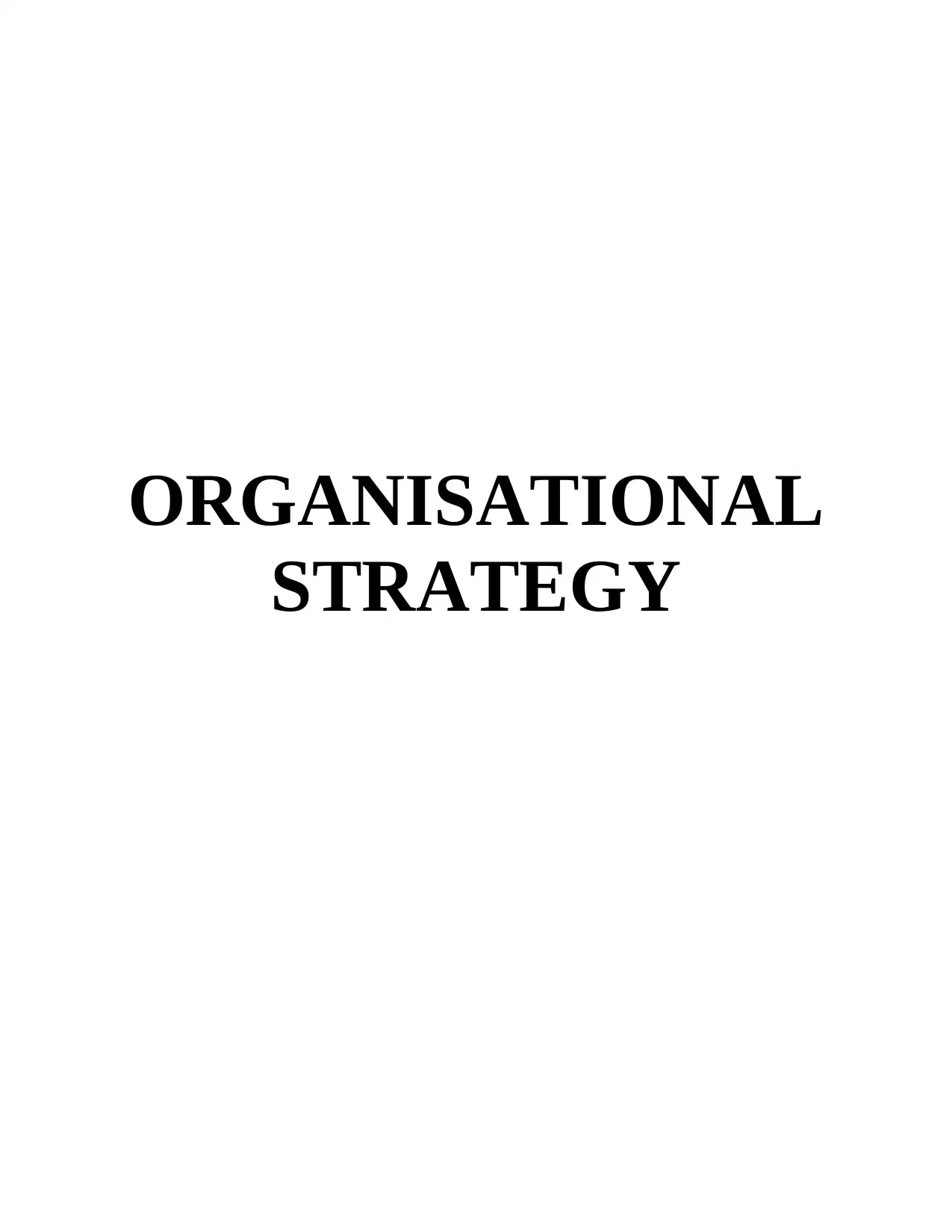
ORGANISATIONAL
STRATEGY
STRATEGY
Paraphrase This Document
Need a fresh take? Get an instant paraphrase of this document with our AI Paraphraser
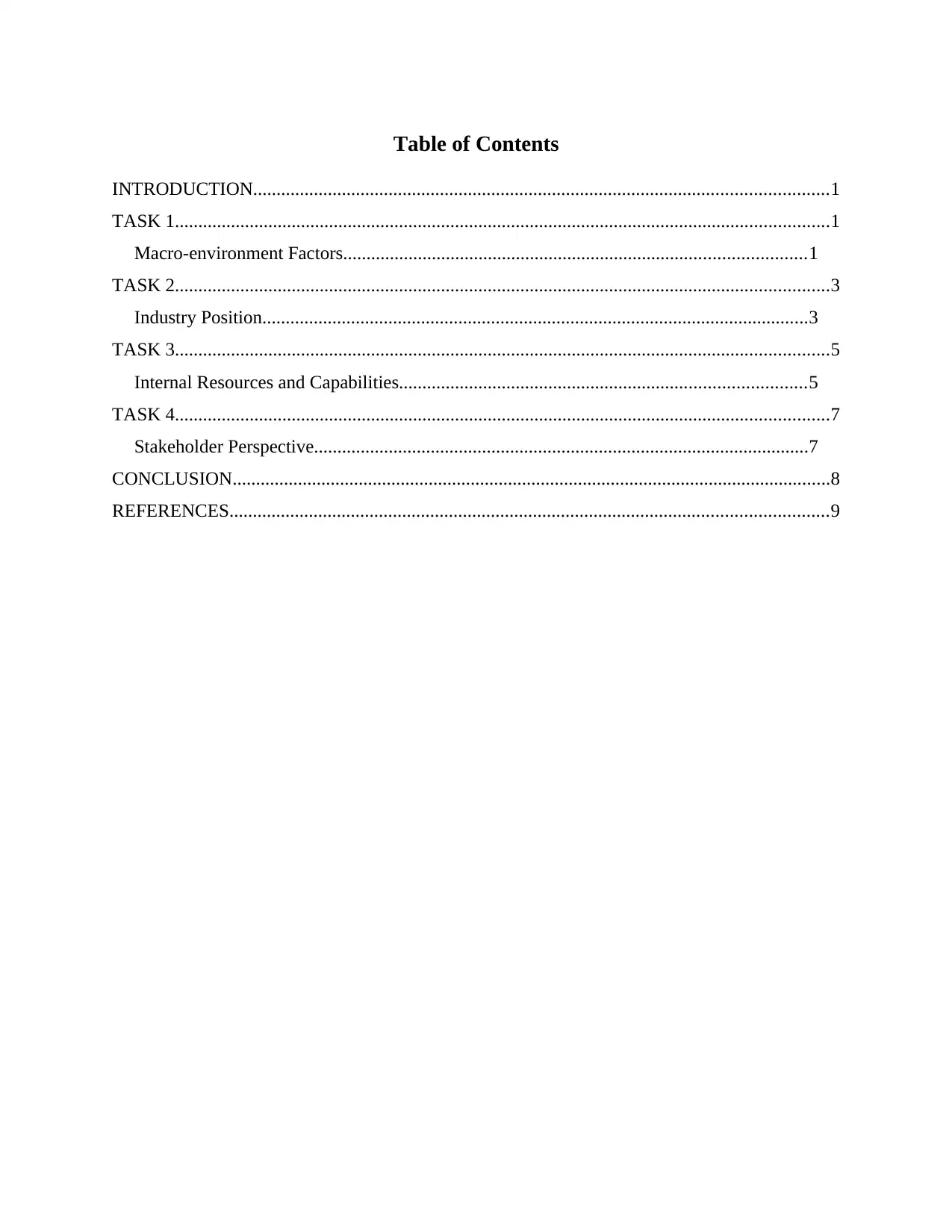
Table of Contents
INTRODUCTION...........................................................................................................................1
TASK 1............................................................................................................................................1
Macro-environment Factors...................................................................................................1
TASK 2............................................................................................................................................3
Industry Position.....................................................................................................................3
TASK 3............................................................................................................................................5
Internal Resources and Capabilities.......................................................................................5
TASK 4............................................................................................................................................7
Stakeholder Perspective..........................................................................................................7
CONCLUSION................................................................................................................................8
REFERENCES................................................................................................................................9
INTRODUCTION...........................................................................................................................1
TASK 1............................................................................................................................................1
Macro-environment Factors...................................................................................................1
TASK 2............................................................................................................................................3
Industry Position.....................................................................................................................3
TASK 3............................................................................................................................................5
Internal Resources and Capabilities.......................................................................................5
TASK 4............................................................................................................................................7
Stakeholder Perspective..........................................................................................................7
CONCLUSION................................................................................................................................8
REFERENCES................................................................................................................................9

⊘ This is a preview!⊘
Do you want full access?
Subscribe today to unlock all pages.

Trusted by 1+ million students worldwide
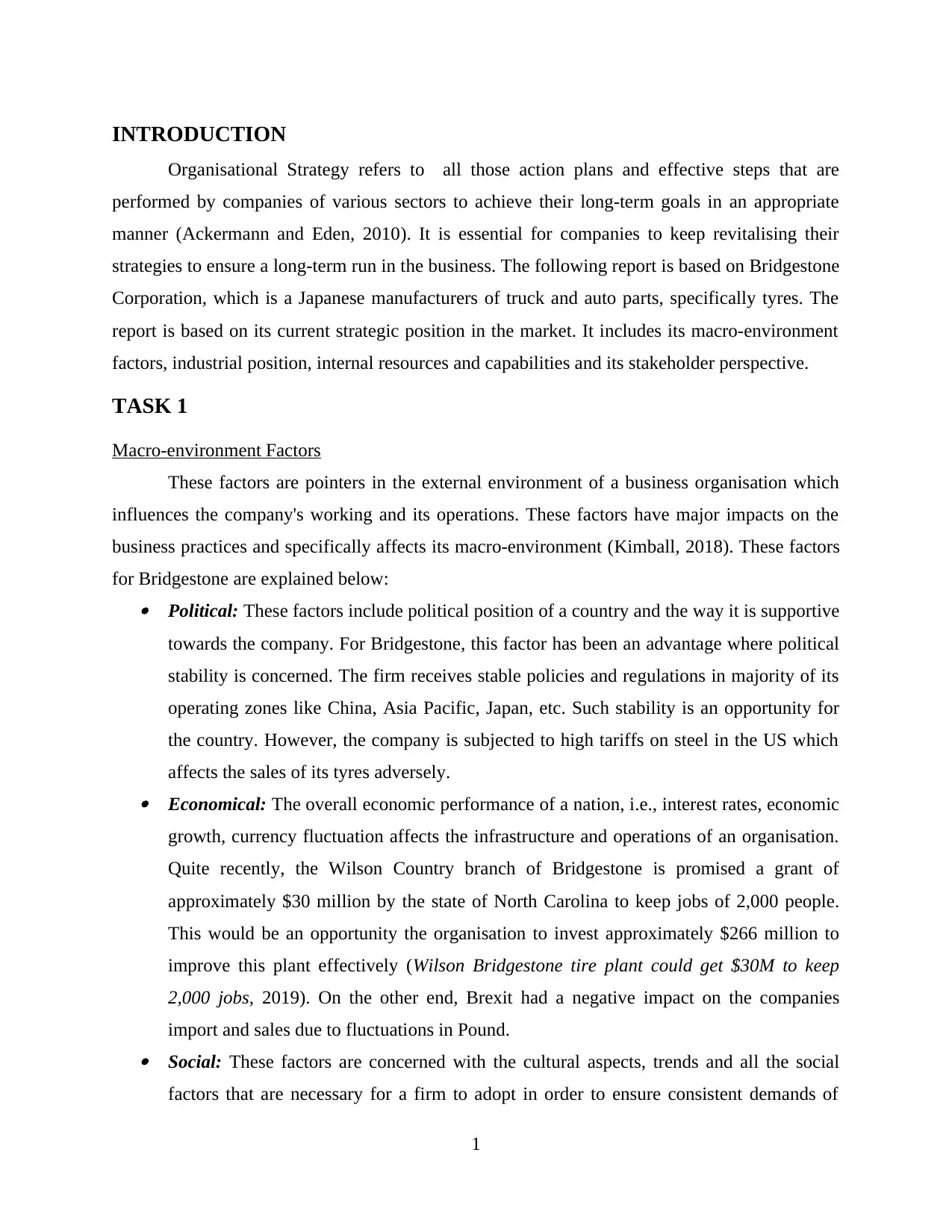
INTRODUCTION
Organisational Strategy refers to all those action plans and effective steps that are
performed by companies of various sectors to achieve their long-term goals in an appropriate
manner (Ackermann and Eden, 2010). It is essential for companies to keep revitalising their
strategies to ensure a long-term run in the business. The following report is based on Bridgestone
Corporation, which is a Japanese manufacturers of truck and auto parts, specifically tyres. The
report is based on its current strategic position in the market. It includes its macro-environment
factors, industrial position, internal resources and capabilities and its stakeholder perspective.
TASK 1
Macro-environment Factors
These factors are pointers in the external environment of a business organisation which
influences the company's working and its operations. These factors have major impacts on the
business practices and specifically affects its macro-environment (Kimball, 2018). These factors
for Bridgestone are explained below: Political: These factors include political position of a country and the way it is supportive
towards the company. For Bridgestone, this factor has been an advantage where political
stability is concerned. The firm receives stable policies and regulations in majority of its
operating zones like China, Asia Pacific, Japan, etc. Such stability is an opportunity for
the country. However, the company is subjected to high tariffs on steel in the US which
affects the sales of its tyres adversely. Economical: The overall economic performance of a nation, i.e., interest rates, economic
growth, currency fluctuation affects the infrastructure and operations of an organisation.
Quite recently, the Wilson Country branch of Bridgestone is promised a grant of
approximately $30 million by the state of North Carolina to keep jobs of 2,000 people.
This would be an opportunity the organisation to invest approximately $266 million to
improve this plant effectively (Wilson Bridgestone tire plant could get $30M to keep
2,000 jobs, 2019). On the other end, Brexit had a negative impact on the companies
import and sales due to fluctuations in Pound. Social: These factors are concerned with the cultural aspects, trends and all the social
factors that are necessary for a firm to adopt in order to ensure consistent demands of
1
Organisational Strategy refers to all those action plans and effective steps that are
performed by companies of various sectors to achieve their long-term goals in an appropriate
manner (Ackermann and Eden, 2010). It is essential for companies to keep revitalising their
strategies to ensure a long-term run in the business. The following report is based on Bridgestone
Corporation, which is a Japanese manufacturers of truck and auto parts, specifically tyres. The
report is based on its current strategic position in the market. It includes its macro-environment
factors, industrial position, internal resources and capabilities and its stakeholder perspective.
TASK 1
Macro-environment Factors
These factors are pointers in the external environment of a business organisation which
influences the company's working and its operations. These factors have major impacts on the
business practices and specifically affects its macro-environment (Kimball, 2018). These factors
for Bridgestone are explained below: Political: These factors include political position of a country and the way it is supportive
towards the company. For Bridgestone, this factor has been an advantage where political
stability is concerned. The firm receives stable policies and regulations in majority of its
operating zones like China, Asia Pacific, Japan, etc. Such stability is an opportunity for
the country. However, the company is subjected to high tariffs on steel in the US which
affects the sales of its tyres adversely. Economical: The overall economic performance of a nation, i.e., interest rates, economic
growth, currency fluctuation affects the infrastructure and operations of an organisation.
Quite recently, the Wilson Country branch of Bridgestone is promised a grant of
approximately $30 million by the state of North Carolina to keep jobs of 2,000 people.
This would be an opportunity the organisation to invest approximately $266 million to
improve this plant effectively (Wilson Bridgestone tire plant could get $30M to keep
2,000 jobs, 2019). On the other end, Brexit had a negative impact on the companies
import and sales due to fluctuations in Pound. Social: These factors are concerned with the cultural aspects, trends and all the social
factors that are necessary for a firm to adopt in order to ensure consistent demands of
1
Paraphrase This Document
Need a fresh take? Get an instant paraphrase of this document with our AI Paraphraser
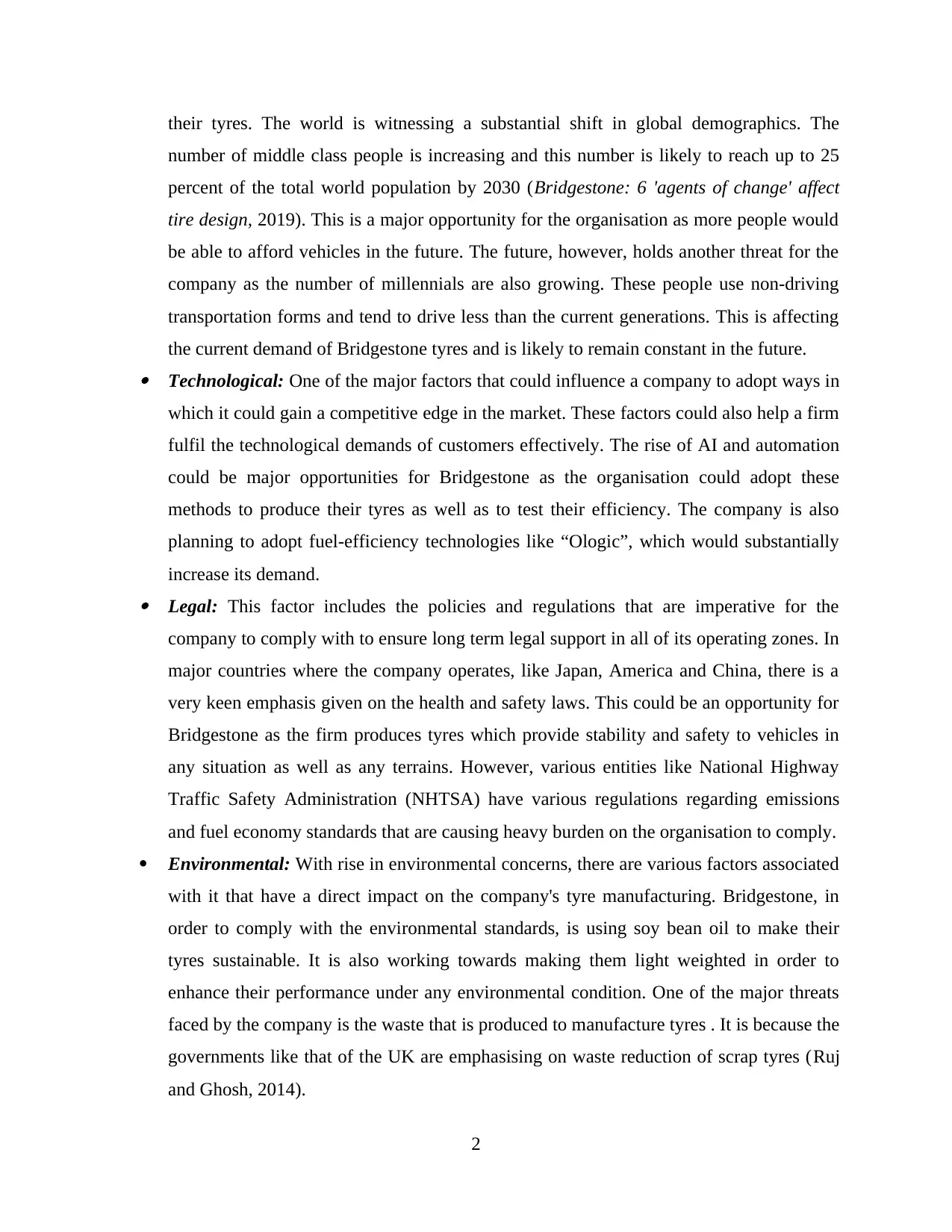
their tyres. The world is witnessing a substantial shift in global demographics. The
number of middle class people is increasing and this number is likely to reach up to 25
percent of the total world population by 2030 (Bridgestone: 6 'agents of change' affect
tire design, 2019). This is a major opportunity for the organisation as more people would
be able to afford vehicles in the future. The future, however, holds another threat for the
company as the number of millennials are also growing. These people use non-driving
transportation forms and tend to drive less than the current generations. This is affecting
the current demand of Bridgestone tyres and is likely to remain constant in the future. Technological: One of the major factors that could influence a company to adopt ways in
which it could gain a competitive edge in the market. These factors could also help a firm
fulfil the technological demands of customers effectively. The rise of AI and automation
could be major opportunities for Bridgestone as the organisation could adopt these
methods to produce their tyres as well as to test their efficiency. The company is also
planning to adopt fuel-efficiency technologies like “Ologic”, which would substantially
increase its demand. Legal: This factor includes the policies and regulations that are imperative for the
company to comply with to ensure long term legal support in all of its operating zones. In
major countries where the company operates, like Japan, America and China, there is a
very keen emphasis given on the health and safety laws. This could be an opportunity for
Bridgestone as the firm produces tyres which provide stability and safety to vehicles in
any situation as well as any terrains. However, various entities like National Highway
Traffic Safety Administration (NHTSA) have various regulations regarding emissions
and fuel economy standards that are causing heavy burden on the organisation to comply.
Environmental: With rise in environmental concerns, there are various factors associated
with it that have a direct impact on the company's tyre manufacturing. Bridgestone, in
order to comply with the environmental standards, is using soy bean oil to make their
tyres sustainable. It is also working towards making them light weighted in order to
enhance their performance under any environmental condition. One of the major threats
faced by the company is the waste that is produced to manufacture tyres . It is because the
governments like that of the UK are emphasising on waste reduction of scrap tyres (Ruj
and Ghosh, 2014).
2
number of middle class people is increasing and this number is likely to reach up to 25
percent of the total world population by 2030 (Bridgestone: 6 'agents of change' affect
tire design, 2019). This is a major opportunity for the organisation as more people would
be able to afford vehicles in the future. The future, however, holds another threat for the
company as the number of millennials are also growing. These people use non-driving
transportation forms and tend to drive less than the current generations. This is affecting
the current demand of Bridgestone tyres and is likely to remain constant in the future. Technological: One of the major factors that could influence a company to adopt ways in
which it could gain a competitive edge in the market. These factors could also help a firm
fulfil the technological demands of customers effectively. The rise of AI and automation
could be major opportunities for Bridgestone as the organisation could adopt these
methods to produce their tyres as well as to test their efficiency. The company is also
planning to adopt fuel-efficiency technologies like “Ologic”, which would substantially
increase its demand. Legal: This factor includes the policies and regulations that are imperative for the
company to comply with to ensure long term legal support in all of its operating zones. In
major countries where the company operates, like Japan, America and China, there is a
very keen emphasis given on the health and safety laws. This could be an opportunity for
Bridgestone as the firm produces tyres which provide stability and safety to vehicles in
any situation as well as any terrains. However, various entities like National Highway
Traffic Safety Administration (NHTSA) have various regulations regarding emissions
and fuel economy standards that are causing heavy burden on the organisation to comply.
Environmental: With rise in environmental concerns, there are various factors associated
with it that have a direct impact on the company's tyre manufacturing. Bridgestone, in
order to comply with the environmental standards, is using soy bean oil to make their
tyres sustainable. It is also working towards making them light weighted in order to
enhance their performance under any environmental condition. One of the major threats
faced by the company is the waste that is produced to manufacture tyres . It is because the
governments like that of the UK are emphasising on waste reduction of scrap tyres (Ruj
and Ghosh, 2014).
2

TASK 2
Industry Position
After determining the external pointers, it is imperative that a firm determines its
industrial position to effectively identify strategies that are necessary for the company to ensure
its long-term sustainability in the market (E. Dobbs, 2014). For this purpose, the most
appropriate approach would be to apply Porter's Five Force analysis which is discussed below: Buyers' Power: The buyers of the organisation are mostly auto-mobile companies like
Toyota, Land Rover, Chevrolet and so forth. Automobile industry is connected globally
and hence, the company supplies its tyres worldwide. There are many firms that act as a
customer of the firm. From standard quality tyres to Formula 1, Bridgestone is trusted
and preferred over very prominent companies. Such unique product quality reduces the
bargaining power of customers. Moreover, with availability of less substitutes in the
market, the firm holds the pricing of its tyres. Thus, the bargaining power of buyers is
low in case of Bridgestone. Suppliers' Power: Automobile industry have various small as well as large scale
suppliers on a global level. Bridgestone too has certain prominent suppliers of rubber,
alloys and effective technology required to build tyres. The power of the pricing lies with
the company as it could effectively switch suppliers without incurring much cost which
could be threatening for suppliers' profit margin. Thus, the bargaining power of suppliers
is low for Bridgestone. Threat of Substitutes: These are the products that could be effectively be used in place of
the existing offerings (Misangyi and Acharya, 2014). For Bridgestone, this threat is
negligible as the technology that could replace tyres in the automobile industry is still in
the process of development. There could be modifications and innovations associated
with the tyres, but currently there are no substitute products for the same which could
completely replace the its existence in the automobile industry. As for the company, it
faces no threat regarding any substitute in the market. Threat of New Entrants: Bridgestone is an established company and one of the market
leaders in the tyre industry. However, automobile industry is one of the most profitable
industries in the world which could attract various investors from all over the world to
3
Industry Position
After determining the external pointers, it is imperative that a firm determines its
industrial position to effectively identify strategies that are necessary for the company to ensure
its long-term sustainability in the market (E. Dobbs, 2014). For this purpose, the most
appropriate approach would be to apply Porter's Five Force analysis which is discussed below: Buyers' Power: The buyers of the organisation are mostly auto-mobile companies like
Toyota, Land Rover, Chevrolet and so forth. Automobile industry is connected globally
and hence, the company supplies its tyres worldwide. There are many firms that act as a
customer of the firm. From standard quality tyres to Formula 1, Bridgestone is trusted
and preferred over very prominent companies. Such unique product quality reduces the
bargaining power of customers. Moreover, with availability of less substitutes in the
market, the firm holds the pricing of its tyres. Thus, the bargaining power of buyers is
low in case of Bridgestone. Suppliers' Power: Automobile industry have various small as well as large scale
suppliers on a global level. Bridgestone too has certain prominent suppliers of rubber,
alloys and effective technology required to build tyres. The power of the pricing lies with
the company as it could effectively switch suppliers without incurring much cost which
could be threatening for suppliers' profit margin. Thus, the bargaining power of suppliers
is low for Bridgestone. Threat of Substitutes: These are the products that could be effectively be used in place of
the existing offerings (Misangyi and Acharya, 2014). For Bridgestone, this threat is
negligible as the technology that could replace tyres in the automobile industry is still in
the process of development. There could be modifications and innovations associated
with the tyres, but currently there are no substitute products for the same which could
completely replace the its existence in the automobile industry. As for the company, it
faces no threat regarding any substitute in the market. Threat of New Entrants: Bridgestone is an established company and one of the market
leaders in the tyre industry. However, automobile industry is one of the most profitable
industries in the world which could attract various investors from all over the world to
3
⊘ This is a preview!⊘
Do you want full access?
Subscribe today to unlock all pages.

Trusted by 1+ million students worldwide
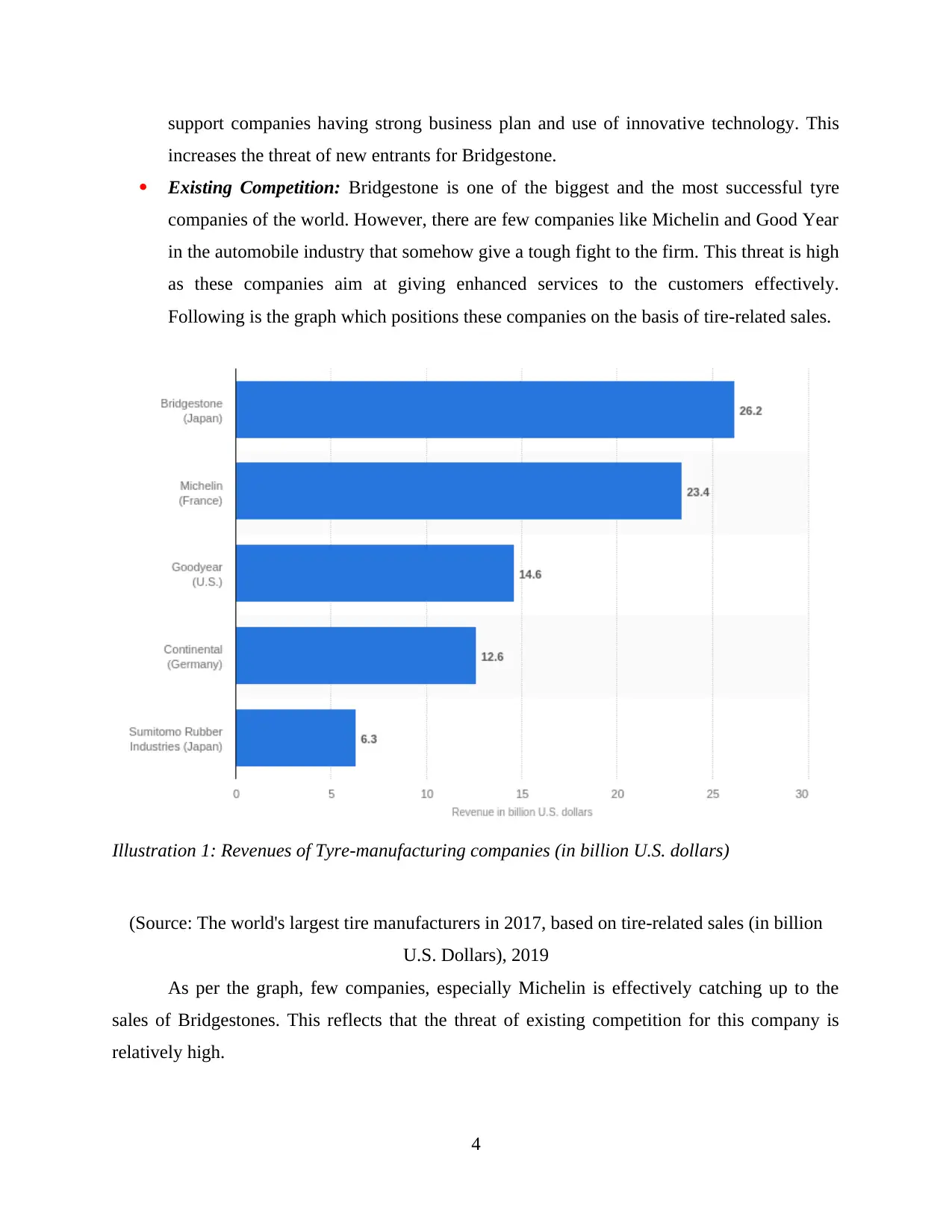
support companies having strong business plan and use of innovative technology. This
increases the threat of new entrants for Bridgestone.
Existing Competition: Bridgestone is one of the biggest and the most successful tyre
companies of the world. However, there are few companies like Michelin and Good Year
in the automobile industry that somehow give a tough fight to the firm. This threat is high
as these companies aim at giving enhanced services to the customers effectively.
Following is the graph which positions these companies on the basis of tire-related sales.
Illustration 1: Revenues of Tyre-manufacturing companies (in billion U.S. dollars)
(Source: The world's largest tire manufacturers in 2017, based on tire-related sales (in billion
U.S. Dollars), 2019
As per the graph, few companies, especially Michelin is effectively catching up to the
sales of Bridgestones. This reflects that the threat of existing competition for this company is
relatively high.
4
increases the threat of new entrants for Bridgestone.
Existing Competition: Bridgestone is one of the biggest and the most successful tyre
companies of the world. However, there are few companies like Michelin and Good Year
in the automobile industry that somehow give a tough fight to the firm. This threat is high
as these companies aim at giving enhanced services to the customers effectively.
Following is the graph which positions these companies on the basis of tire-related sales.
Illustration 1: Revenues of Tyre-manufacturing companies (in billion U.S. dollars)
(Source: The world's largest tire manufacturers in 2017, based on tire-related sales (in billion
U.S. Dollars), 2019
As per the graph, few companies, especially Michelin is effectively catching up to the
sales of Bridgestones. This reflects that the threat of existing competition for this company is
relatively high.
4
Paraphrase This Document
Need a fresh take? Get an instant paraphrase of this document with our AI Paraphraser
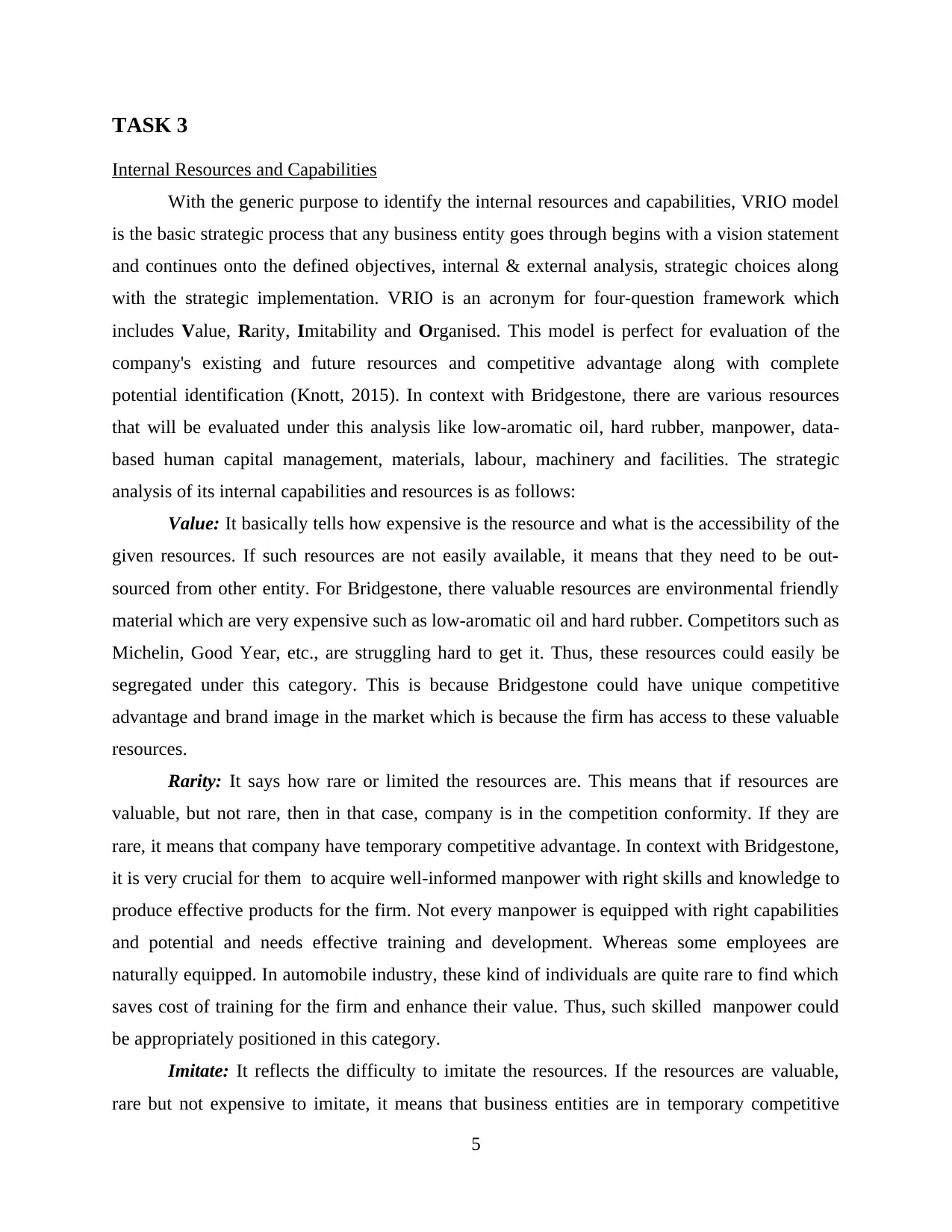
TASK 3
Internal Resources and Capabilities
With the generic purpose to identify the internal resources and capabilities, VRIO model
is the basic strategic process that any business entity goes through begins with a vision statement
and continues onto the defined objectives, internal & external analysis, strategic choices along
with the strategic implementation. VRIO is an acronym for four-question framework which
includes Value, Rarity, Imitability and Organised. This model is perfect for evaluation of the
company's existing and future resources and competitive advantage along with complete
potential identification (Knott, 2015). In context with Bridgestone, there are various resources
that will be evaluated under this analysis like low-aromatic oil, hard rubber, manpower, data-
based human capital management, materials, labour, machinery and facilities. The strategic
analysis of its internal capabilities and resources is as follows:
Value: It basically tells how expensive is the resource and what is the accessibility of the
given resources. If such resources are not easily available, it means that they need to be out-
sourced from other entity. For Bridgestone, there valuable resources are environmental friendly
material which are very expensive such as low-aromatic oil and hard rubber. Competitors such as
Michelin, Good Year, etc., are struggling hard to get it. Thus, these resources could easily be
segregated under this category. This is because Bridgestone could have unique competitive
advantage and brand image in the market which is because the firm has access to these valuable
resources.
Rarity: It says how rare or limited the resources are. This means that if resources are
valuable, but not rare, then in that case, company is in the competition conformity. If they are
rare, it means that company have temporary competitive advantage. In context with Bridgestone,
it is very crucial for them to acquire well-informed manpower with right skills and knowledge to
produce effective products for the firm. Not every manpower is equipped with right capabilities
and potential and needs effective training and development. Whereas some employees are
naturally equipped. In automobile industry, these kind of individuals are quite rare to find which
saves cost of training for the firm and enhance their value. Thus, such skilled manpower could
be appropriately positioned in this category.
Imitate: It reflects the difficulty to imitate the resources. If the resources are valuable,
rare but not expensive to imitate, it means that business entities are in temporary competitive
5
Internal Resources and Capabilities
With the generic purpose to identify the internal resources and capabilities, VRIO model
is the basic strategic process that any business entity goes through begins with a vision statement
and continues onto the defined objectives, internal & external analysis, strategic choices along
with the strategic implementation. VRIO is an acronym for four-question framework which
includes Value, Rarity, Imitability and Organised. This model is perfect for evaluation of the
company's existing and future resources and competitive advantage along with complete
potential identification (Knott, 2015). In context with Bridgestone, there are various resources
that will be evaluated under this analysis like low-aromatic oil, hard rubber, manpower, data-
based human capital management, materials, labour, machinery and facilities. The strategic
analysis of its internal capabilities and resources is as follows:
Value: It basically tells how expensive is the resource and what is the accessibility of the
given resources. If such resources are not easily available, it means that they need to be out-
sourced from other entity. For Bridgestone, there valuable resources are environmental friendly
material which are very expensive such as low-aromatic oil and hard rubber. Competitors such as
Michelin, Good Year, etc., are struggling hard to get it. Thus, these resources could easily be
segregated under this category. This is because Bridgestone could have unique competitive
advantage and brand image in the market which is because the firm has access to these valuable
resources.
Rarity: It says how rare or limited the resources are. This means that if resources are
valuable, but not rare, then in that case, company is in the competition conformity. If they are
rare, it means that company have temporary competitive advantage. In context with Bridgestone,
it is very crucial for them to acquire well-informed manpower with right skills and knowledge to
produce effective products for the firm. Not every manpower is equipped with right capabilities
and potential and needs effective training and development. Whereas some employees are
naturally equipped. In automobile industry, these kind of individuals are quite rare to find which
saves cost of training for the firm and enhance their value. Thus, such skilled manpower could
be appropriately positioned in this category.
Imitate: It reflects the difficulty to imitate the resources. If the resources are valuable,
rare but not expensive to imitate, it means that business entities are in temporary competitive
5
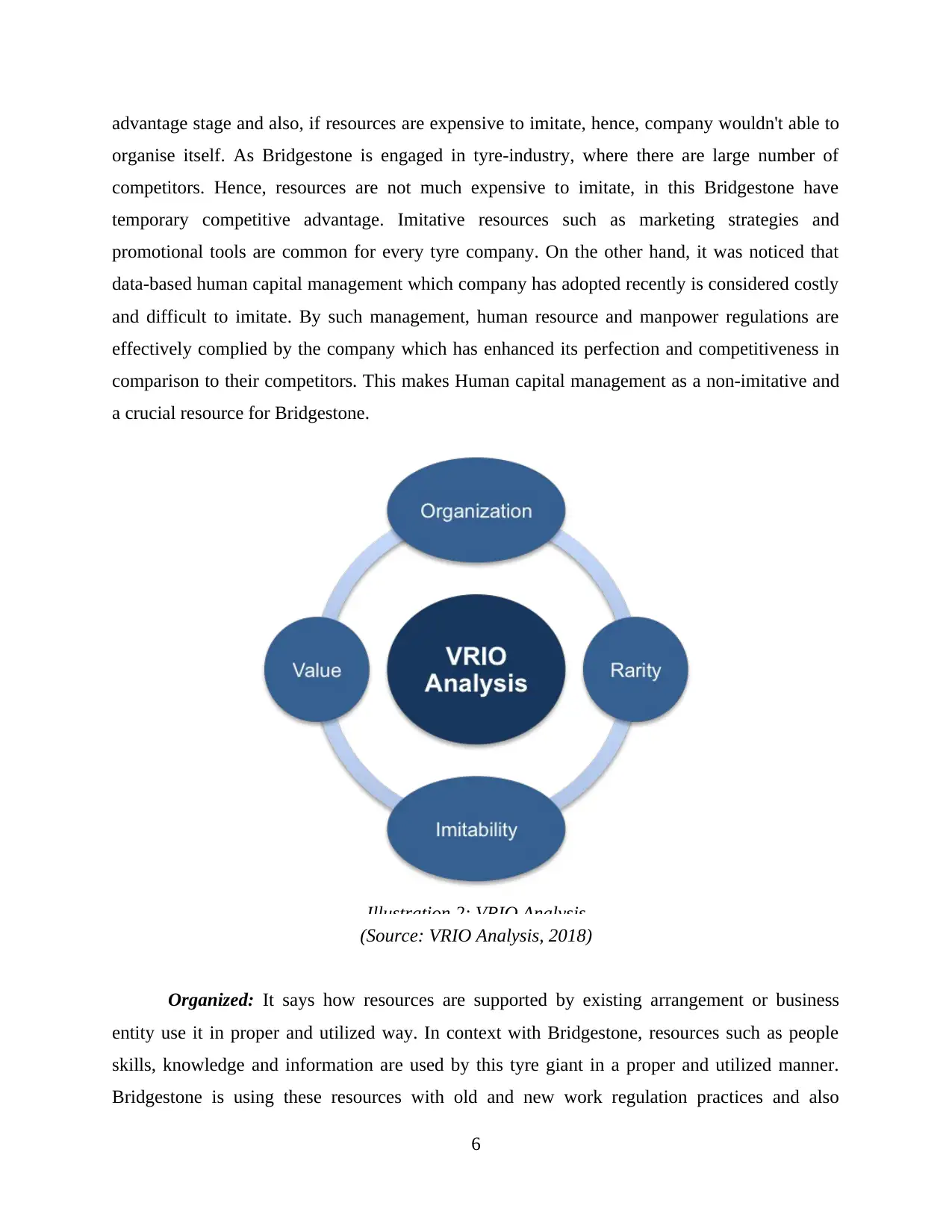
advantage stage and also, if resources are expensive to imitate, hence, company wouldn't able to
organise itself. As Bridgestone is engaged in tyre-industry, where there are large number of
competitors. Hence, resources are not much expensive to imitate, in this Bridgestone have
temporary competitive advantage. Imitative resources such as marketing strategies and
promotional tools are common for every tyre company. On the other hand, it was noticed that
data-based human capital management which company has adopted recently is considered costly
and difficult to imitate. By such management, human resource and manpower regulations are
effectively complied by the company which has enhanced its perfection and competitiveness in
comparison to their competitors. This makes Human capital management as a non-imitative and
a crucial resource for Bridgestone.
(Source: VRIO Analysis, 2018)
Organized: It says how resources are supported by existing arrangement or business
entity use it in proper and utilized way. In context with Bridgestone, resources such as people
skills, knowledge and information are used by this tyre giant in a proper and utilized manner.
Bridgestone is using these resources with old and new work regulation practices and also
6
Illustration 2: VRIO Analysis
organise itself. As Bridgestone is engaged in tyre-industry, where there are large number of
competitors. Hence, resources are not much expensive to imitate, in this Bridgestone have
temporary competitive advantage. Imitative resources such as marketing strategies and
promotional tools are common for every tyre company. On the other hand, it was noticed that
data-based human capital management which company has adopted recently is considered costly
and difficult to imitate. By such management, human resource and manpower regulations are
effectively complied by the company which has enhanced its perfection and competitiveness in
comparison to their competitors. This makes Human capital management as a non-imitative and
a crucial resource for Bridgestone.
(Source: VRIO Analysis, 2018)
Organized: It says how resources are supported by existing arrangement or business
entity use it in proper and utilized way. In context with Bridgestone, resources such as people
skills, knowledge and information are used by this tyre giant in a proper and utilized manner.
Bridgestone is using these resources with old and new work regulation practices and also
6
Illustration 2: VRIO Analysis
⊘ This is a preview!⊘
Do you want full access?
Subscribe today to unlock all pages.

Trusted by 1+ million students worldwide
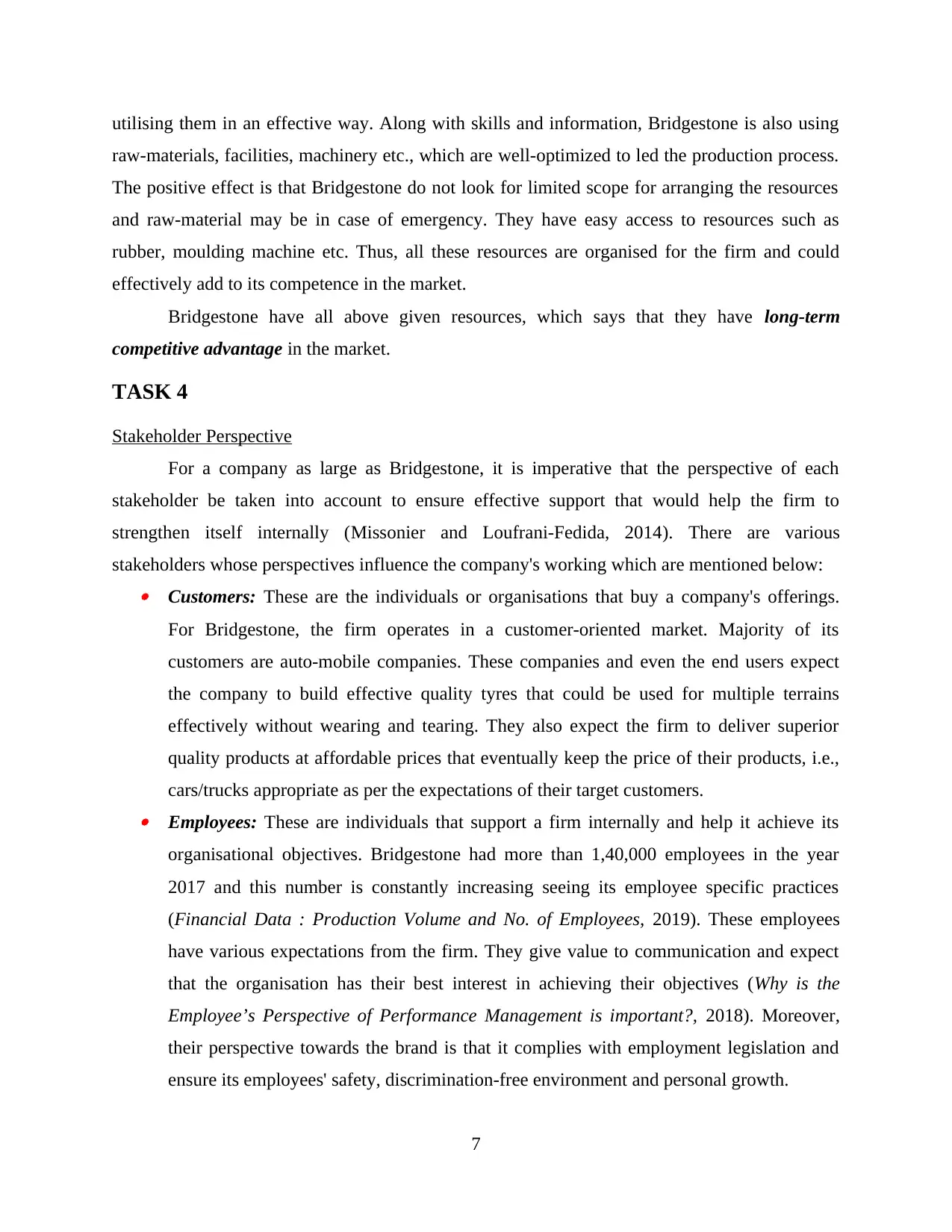
utilising them in an effective way. Along with skills and information, Bridgestone is also using
raw-materials, facilities, machinery etc., which are well-optimized to led the production process.
The positive effect is that Bridgestone do not look for limited scope for arranging the resources
and raw-material may be in case of emergency. They have easy access to resources such as
rubber, moulding machine etc. Thus, all these resources are organised for the firm and could
effectively add to its competence in the market.
Bridgestone have all above given resources, which says that they have long-term
competitive advantage in the market.
TASK 4
Stakeholder Perspective
For a company as large as Bridgestone, it is imperative that the perspective of each
stakeholder be taken into account to ensure effective support that would help the firm to
strengthen itself internally (Missonier and Loufrani-Fedida, 2014). There are various
stakeholders whose perspectives influence the company's working which are mentioned below: Customers: These are the individuals or organisations that buy a company's offerings.
For Bridgestone, the firm operates in a customer-oriented market. Majority of its
customers are auto-mobile companies. These companies and even the end users expect
the company to build effective quality tyres that could be used for multiple terrains
effectively without wearing and tearing. They also expect the firm to deliver superior
quality products at affordable prices that eventually keep the price of their products, i.e.,
cars/trucks appropriate as per the expectations of their target customers. Employees: These are individuals that support a firm internally and help it achieve its
organisational objectives. Bridgestone had more than 1,40,000 employees in the year
2017 and this number is constantly increasing seeing its employee specific practices
(Financial Data : Production Volume and No. of Employees, 2019). These employees
have various expectations from the firm. They give value to communication and expect
that the organisation has their best interest in achieving their objectives (Why is the
Employee’s Perspective of Performance Management is important?, 2018). Moreover,
their perspective towards the brand is that it complies with employment legislation and
ensure its employees' safety, discrimination-free environment and personal growth.
7
raw-materials, facilities, machinery etc., which are well-optimized to led the production process.
The positive effect is that Bridgestone do not look for limited scope for arranging the resources
and raw-material may be in case of emergency. They have easy access to resources such as
rubber, moulding machine etc. Thus, all these resources are organised for the firm and could
effectively add to its competence in the market.
Bridgestone have all above given resources, which says that they have long-term
competitive advantage in the market.
TASK 4
Stakeholder Perspective
For a company as large as Bridgestone, it is imperative that the perspective of each
stakeholder be taken into account to ensure effective support that would help the firm to
strengthen itself internally (Missonier and Loufrani-Fedida, 2014). There are various
stakeholders whose perspectives influence the company's working which are mentioned below: Customers: These are the individuals or organisations that buy a company's offerings.
For Bridgestone, the firm operates in a customer-oriented market. Majority of its
customers are auto-mobile companies. These companies and even the end users expect
the company to build effective quality tyres that could be used for multiple terrains
effectively without wearing and tearing. They also expect the firm to deliver superior
quality products at affordable prices that eventually keep the price of their products, i.e.,
cars/trucks appropriate as per the expectations of their target customers. Employees: These are individuals that support a firm internally and help it achieve its
organisational objectives. Bridgestone had more than 1,40,000 employees in the year
2017 and this number is constantly increasing seeing its employee specific practices
(Financial Data : Production Volume and No. of Employees, 2019). These employees
have various expectations from the firm. They give value to communication and expect
that the organisation has their best interest in achieving their objectives (Why is the
Employee’s Perspective of Performance Management is important?, 2018). Moreover,
their perspective towards the brand is that it complies with employment legislation and
ensure its employees' safety, discrimination-free environment and personal growth.
7
Paraphrase This Document
Need a fresh take? Get an instant paraphrase of this document with our AI Paraphraser
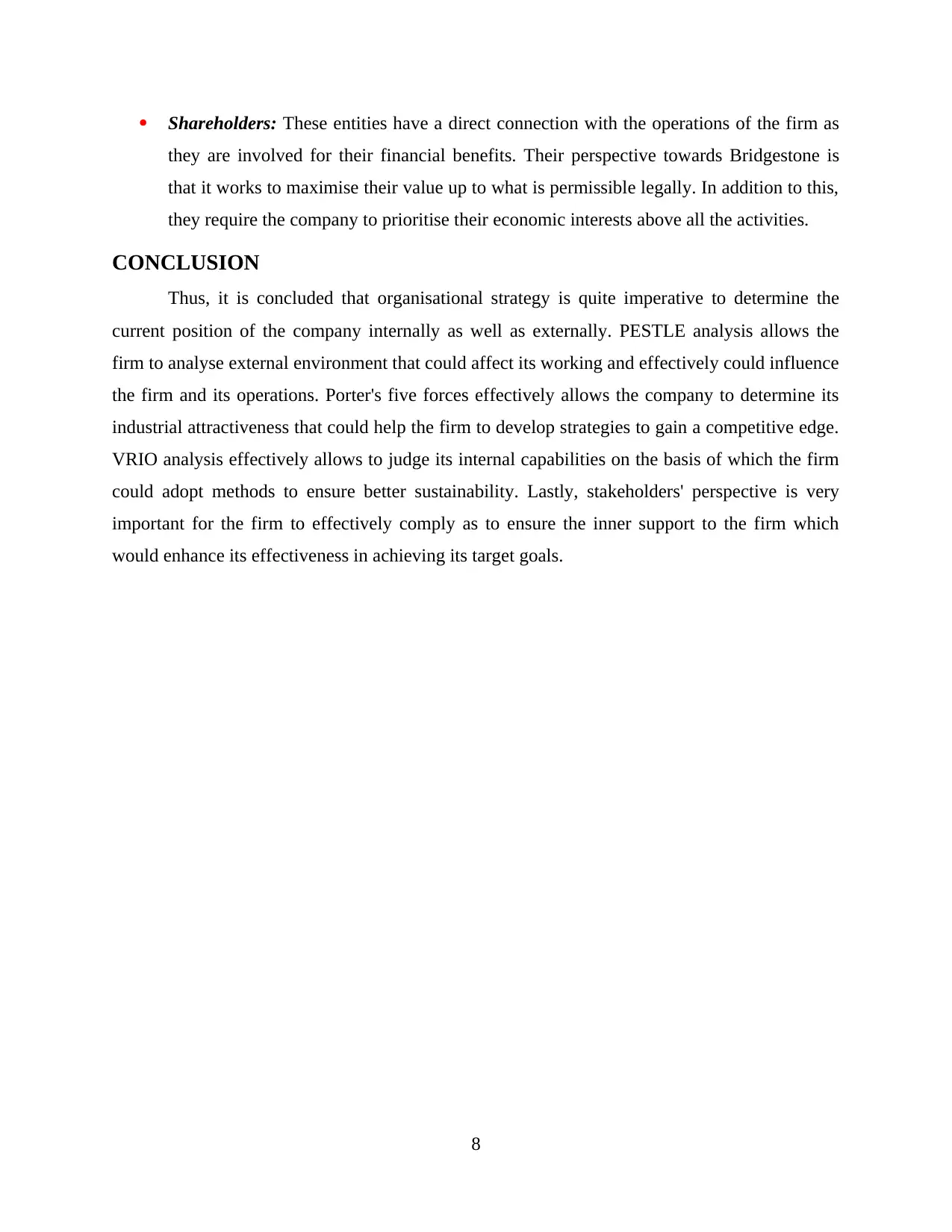
Shareholders: These entities have a direct connection with the operations of the firm as
they are involved for their financial benefits. Their perspective towards Bridgestone is
that it works to maximise their value up to what is permissible legally. In addition to this,
they require the company to prioritise their economic interests above all the activities.
CONCLUSION
Thus, it is concluded that organisational strategy is quite imperative to determine the
current position of the company internally as well as externally. PESTLE analysis allows the
firm to analyse external environment that could affect its working and effectively could influence
the firm and its operations. Porter's five forces effectively allows the company to determine its
industrial attractiveness that could help the firm to develop strategies to gain a competitive edge.
VRIO analysis effectively allows to judge its internal capabilities on the basis of which the firm
could adopt methods to ensure better sustainability. Lastly, stakeholders' perspective is very
important for the firm to effectively comply as to ensure the inner support to the firm which
would enhance its effectiveness in achieving its target goals.
8
they are involved for their financial benefits. Their perspective towards Bridgestone is
that it works to maximise their value up to what is permissible legally. In addition to this,
they require the company to prioritise their economic interests above all the activities.
CONCLUSION
Thus, it is concluded that organisational strategy is quite imperative to determine the
current position of the company internally as well as externally. PESTLE analysis allows the
firm to analyse external environment that could affect its working and effectively could influence
the firm and its operations. Porter's five forces effectively allows the company to determine its
industrial attractiveness that could help the firm to develop strategies to gain a competitive edge.
VRIO analysis effectively allows to judge its internal capabilities on the basis of which the firm
could adopt methods to ensure better sustainability. Lastly, stakeholders' perspective is very
important for the firm to effectively comply as to ensure the inner support to the firm which
would enhance its effectiveness in achieving its target goals.
8

REFERENCES
Books and Journals
Ackermann, F. and Eden, C., 2010. Business Strategy
E. Dobbs, M., 2014. Guidelines for applying Porter's five forces framework: a set of industry
analysis templates. Competitiveness Review. 24(1). pp.32-45.
Kimball, G., 2018. Outsourcing Agreements: A.
Knott, P.J., 2015. Does VRIO help managers evaluate a firm’s resources?. Management
Decision. 53(8). pp.1806-1822.
Misangyi, V.F. and Acharya, A.G., 2014. Substitutes or complements? A configurational
examination of corporate governance mechanisms. Academy of Management Journal.
57(6). pp.1681-1705.
Missonier, S. and Loufrani-Fedida, S., 2014. Stakeholder analysis and engagement in projects:
From stakeholder relational perspective to stakeholder relational ontology. International
Journal of Project Management. 32(7). pp.1108-1122.
Ruj, B. and Ghosh, S., 2014. Technological aspects for thermal plasma treatment of municipal
solid waste—A review. Fuel processing technology. 126. pp.298-308.
Online
Bridgestone: 6 'agents of change' affect tire design. 2019. [Online] Available through:
<https://www.tirebusiness.com/article/20160630/news/160639992?template=printart/>.
Financial Data : Production Volume and No. of Employees. 2019. [Online] Available through:
<https://www.bridgestone.com/ir/financialdata/production/>.
Why is the Employee’s Perspective of Performance Management is important?. 2018. [Online]
Available through: <https://www.symbiancehr.net/why-is-the-employees-perspective-
of-performance-management-is-important/>.
Wilson Bridgestone tire plant could get $30M to keep 2,000 jobs. 2019. [Online] Available
through: <https://wcti12.com/news/local/wilson-bridgestone-tire-plant-could-get-30m-
to-keep-2000-jobs/>.
9
Books and Journals
Ackermann, F. and Eden, C., 2010. Business Strategy
E. Dobbs, M., 2014. Guidelines for applying Porter's five forces framework: a set of industry
analysis templates. Competitiveness Review. 24(1). pp.32-45.
Kimball, G., 2018. Outsourcing Agreements: A.
Knott, P.J., 2015. Does VRIO help managers evaluate a firm’s resources?. Management
Decision. 53(8). pp.1806-1822.
Misangyi, V.F. and Acharya, A.G., 2014. Substitutes or complements? A configurational
examination of corporate governance mechanisms. Academy of Management Journal.
57(6). pp.1681-1705.
Missonier, S. and Loufrani-Fedida, S., 2014. Stakeholder analysis and engagement in projects:
From stakeholder relational perspective to stakeholder relational ontology. International
Journal of Project Management. 32(7). pp.1108-1122.
Ruj, B. and Ghosh, S., 2014. Technological aspects for thermal plasma treatment of municipal
solid waste—A review. Fuel processing technology. 126. pp.298-308.
Online
Bridgestone: 6 'agents of change' affect tire design. 2019. [Online] Available through:
<https://www.tirebusiness.com/article/20160630/news/160639992?template=printart/>.
Financial Data : Production Volume and No. of Employees. 2019. [Online] Available through:
<https://www.bridgestone.com/ir/financialdata/production/>.
Why is the Employee’s Perspective of Performance Management is important?. 2018. [Online]
Available through: <https://www.symbiancehr.net/why-is-the-employees-perspective-
of-performance-management-is-important/>.
Wilson Bridgestone tire plant could get $30M to keep 2,000 jobs. 2019. [Online] Available
through: <https://wcti12.com/news/local/wilson-bridgestone-tire-plant-could-get-30m-
to-keep-2000-jobs/>.
9
⊘ This is a preview!⊘
Do you want full access?
Subscribe today to unlock all pages.

Trusted by 1+ million students worldwide
1 out of 12
Related Documents
Your All-in-One AI-Powered Toolkit for Academic Success.
+13062052269
info@desklib.com
Available 24*7 on WhatsApp / Email
![[object Object]](/_next/static/media/star-bottom.7253800d.svg)
Unlock your academic potential
Copyright © 2020–2025 A2Z Services. All Rights Reserved. Developed and managed by ZUCOL.





